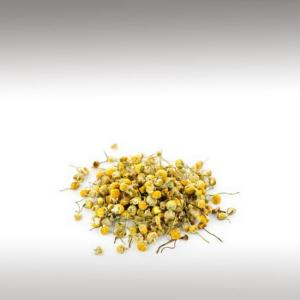
GERMAN CHAMOMILE ESSENTIAL OIL (MATRICARIA RECUTITA) - ESSENTIAL OILS

BASE / GENERAL DATA
Information submited: April 15, 2015 Modified: March 13, 2018 By: OperaDreamhouse
Botanical Name: Matricaria recutita
Common Method of Extraction: Steam distillation
Part Typically Used: Flowers
Color: Dark blue
Consistency: Thin
Perfumery Note: Middle
Strength of Initial Aroma: Sweet, fruity, herbaceous.
Matricaria Chamomilla (Matricaria Recutita), commonly known as Chamomile (also spelled Camomile), German Chamomile, Hungarian Chamomile (Kamilla), Wild Chamomile or Scented Mayweed,is an annual plant of the composite family Asteraceae. Matricaria Chamomilla is the most popular source of the herbal product Chamomile, although other species are also used as Chamomile.
The word Chamomile comes from the Greek "Chamaimēlon" meaning "Earth-Apple", which is derived from "Chamai" meaning "On the ground" and "Mēlon" meaning "Apple". It is so called because of the apple - like scent of the plant.
Matricaria Chamomilla has a branched, erect and smooth stem, which grows to a height of 15 - 60 cm. The long and narrow leaves are pinnate and tripinnate. The flowers are borne in paniculata flower heads (Capitulo). The white ray florets are furnished with a ligule, while the disc florets are yellow. The hollow receptacle is swollen and lacks scales. The flowers bloom in early to midsummer, and have a strong, aromatic smell. it will live more than two years.
Matricaria Chamomilla can be found near populated areas all over Europe and temperate Asia, and it has been widely introduced in temperate North America and Australia. It often grows near roads, around landfills, and in cultivated fields as a weed, because the seeds require open soil to survive. German Chamomile will tolerate many soils, but prefers a sandy, well-drained soil with a pH of 7,0 - 7,5 and full sun.
German Chamomile (Matricaria Recutita) essential oil is derived from a flowering medicinal plant that has truly stood the test of time, with over 2,000 years of documented medical use.
Chamomile essential oil is extracted from the blossom (flowers) of the plant. To extract oil from the plants, most manufacturers use steam distillation. The flowers are placed in a still, where hot steam is then applied. The steam - which must be hot enough to penetrate the plant without burning it - forces the essential oil out of the plant so it can be collected independently. German Chamomile flowers yield only 0.2–0.4% essential oil.
Chemical structure:
Chamomile blue refers to chamazulene, the purified, deep-blue essential oil derived using steam distillation, rather than the plant itself.
Common Method of Extraction: Steam distillation
Part Typically Used: Flowers
Color: Dark blue
Consistency: Thin
Perfumery Note: Middle
Strength of Initial Aroma: Sweet, fruity, herbaceous.
Matricaria Chamomilla (Matricaria Recutita), commonly known as Chamomile (also spelled Camomile), German Chamomile, Hungarian Chamomile (Kamilla), Wild Chamomile or Scented Mayweed,is an annual plant of the composite family Asteraceae. Matricaria Chamomilla is the most popular source of the herbal product Chamomile, although other species are also used as Chamomile.
The word Chamomile comes from the Greek "Chamaimēlon" meaning "Earth-Apple", which is derived from "Chamai" meaning "On the ground" and "Mēlon" meaning "Apple". It is so called because of the apple - like scent of the plant.
Matricaria Chamomilla has a branched, erect and smooth stem, which grows to a height of 15 - 60 cm. The long and narrow leaves are pinnate and tripinnate. The flowers are borne in paniculata flower heads (Capitulo). The white ray florets are furnished with a ligule, while the disc florets are yellow. The hollow receptacle is swollen and lacks scales. The flowers bloom in early to midsummer, and have a strong, aromatic smell. it will live more than two years.
Matricaria Chamomilla can be found near populated areas all over Europe and temperate Asia, and it has been widely introduced in temperate North America and Australia. It often grows near roads, around landfills, and in cultivated fields as a weed, because the seeds require open soil to survive. German Chamomile will tolerate many soils, but prefers a sandy, well-drained soil with a pH of 7,0 - 7,5 and full sun.
German Chamomile (Matricaria Recutita) essential oil is derived from a flowering medicinal plant that has truly stood the test of time, with over 2,000 years of documented medical use.
Chamomile essential oil is extracted from the blossom (flowers) of the plant. To extract oil from the plants, most manufacturers use steam distillation. The flowers are placed in a still, where hot steam is then applied. The steam - which must be hot enough to penetrate the plant without burning it - forces the essential oil out of the plant so it can be collected independently. German Chamomile flowers yield only 0.2–0.4% essential oil.
Chemical structure:
Chamomile blue refers to chamazulene, the purified, deep-blue essential oil derived using steam distillation, rather than the plant itself.

SPIRITUAL PRACTISES DATA

MEDICINE / HEALTH DATA

BEAUTY / COSMETICS DATA

FOOD / COOKING DATA
COMMENTS
No comments.
Newest mixtures containing German Chamomile Essential Oil (Matricaria Recutita):

Oil balm for eyes
July 10, 2015




